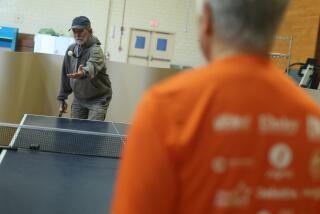Prevention Key to Safer and Sounder Seniors
- Share via
LITTLE ROCK, Ark. — Elva Godwin was playing pingpong in the senior center one day when she fell and broke her shoulder. Some time later, at a friend’s house, she tripped on a step in a dimly lit room and broke the other one.
“I have two artificial shoulders,” said Godwin, of Walnut Ridge.
Godwin, 82, is just the type of person who would benefit most from a program developed by the Centers for Disease Control and Prevention to eliminate falls and fire injuries among people aged 65 and older while making their surroundings safer.
The CDC recently announced $350,000 in grants for programs in Arkansas, Maryland, Minnesota, North Carolina and Virginia.
In 1998, 411 seniors in North Carolina, 341 from Virginia, 186 in Maryland, 127 Arkansas seniors and 101 Minnesotans died as a result of falls, according to those states’ health departments.
That same year, the state agencies said, fire claimed the lives of 30 senior citizens in Arkansas, 30 in Virginia, 23 in North Carolina, 20 in Maryland and 12 in Minnesota.
“Many older adults are at risk. They are frailer. Their reflexes are slower,” said Bettye Watts, fire and fall prevention coordinator for the Arkansas Health Department.
She said a $70,000 CDC grant will allow the state to implement the program, called “Remembering When,” in three communities: Mena, Mountain Home and southeast Pulaski County.
Watts said community volunteers who teach the program will work through senior centers and other organizations to spread their safety message and will also instruct some seniors in their homes. Volunteers should begin teaching in late spring.
The program, developed by the CDC and the National Fire Protection Assn., will provide some participants with smoke alarms, grab bars or nonskid bath mats. “Whatever their needs are,” Watts said.
Godwin, who lives alone, has bars in her bathrooms to keep herself balanced. She said she is limited by how much she can walk although she tries to walk a little every day for exercise.
To limit the possibility of tripping, she said, there are no throw rugs or coffee tables in her home.
For those 65 and older, falls are the leading cause of death from unintentional injury in the home, according to the CDC.
Watts suggests that seniors be made independent in their homes if they are to avoid falls and fires.
To prevent falls, the program advises seniors to exercise regularly to build strength and improve their balance and coordination, take their time getting out of chairs and keep clear pathways in their homes. It is also recommended seniors see an eye doctor once a year and use night lights. Non-slip mats and grab bars can make bathrooms safer.
Minnesota’s community leaders are even being encouraged to look for hazards such as uneven sidewalks.
“There has been a growing realization that falls are a life-threatening or life-changing event. It has a tremendous impact if we can intervene or prevent falls from happening,” said Mari Mevissen of the Minnesota Department of Health.
Watts said the messages for fire and fall safety are the same: Avoid clutter.
Older adults have decreased physical capabilities, making tasks such as cooking more difficult and dangerous.
To avoid fires, the program recommends that seniors use large, deep ashtrays if they smoke and give space heaters lots of room. Seniors can be safer in the kitchen by wearing tight-fitting or rolled-up sleeves when cooking. If clothes catch on fire, stop, drop to the ground, cover your face with your hands and roll over.
Seniors should test their smoke alarms once a month by pushing the test button. They should plan and practice their escape from fire and know their emergency number.
Sarah Olson of the CDC’s home and leisure injury prevention unit said that one out of three people over age 65 will fall each year, with the most serious injury being hip fractures. By age 90, one out of every three people will have suffered a hip fracture, she said.
“Sometimes a hip injury can completely destroy your life,” Watts said.
Half of older adults hospitalized for hip fractures cannot return home or live independently afterward, Olson said.
Many of the tips that program participants get for staying safe may seem obvious, but Watts said that is just the point.
“We all need reminders,” she said, adding that people often don’t think of safety until they suffer a fall or experience a fire.
Bob Young, executive director of the nonprofit organization Healthy Connections in Mena, said the grant will help volunteer groups continue their work to help seniors. Prevention is especially important for seniors living in rural areas because help is often far away.
“Most of the county is served by volunteer fire departments,” he said. “We’re rural and remote in nature. If someone is in the mountains, it might take a while to get to them and that would be too long.”
More to Read
Sign up for Essential California
The most important California stories and recommendations in your inbox every morning.
You may occasionally receive promotional content from the Los Angeles Times.













